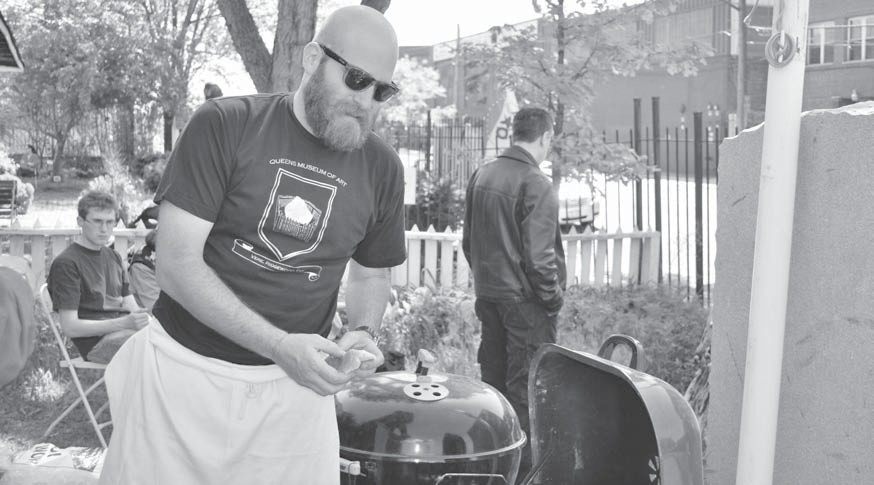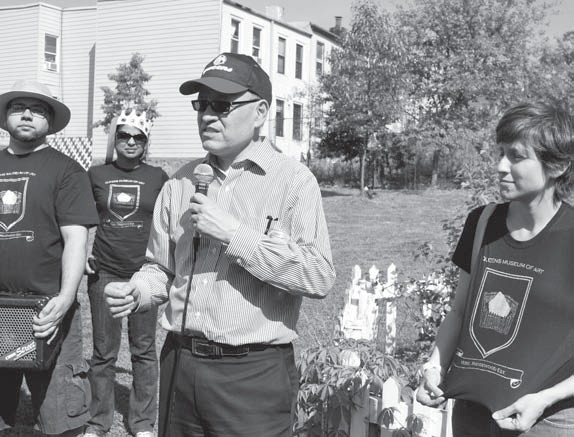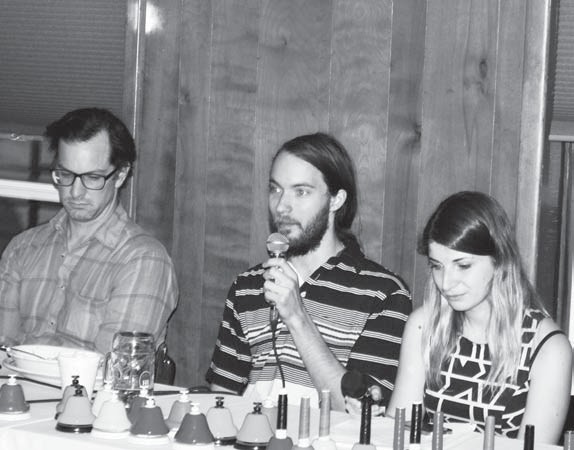Exploring The Work Of Artists On The Queens Side Of The Border
Taking advantage of a beautiful spring day and the sights of a burgeoning art scene, the Queens Museum of Art (QMA) invited residents on the first Ridgewood Art Crawl last Saturday, May 12, offering a tour of the area’s new creative hot spots.

The day began at the Vander-Ende Onderdonk House in Ridgewood, where QMA employees, including Director of External Affairs David Strauss, served up hot dogs and veggie burgers, and also helped some of the neighborhood’s younger art lovers create their own “crowns” to represent Kings or Queens County.
QMA Curator Larissa Harris told the Times Newsweekly at the house that the decision to come to Ridgewood came as an outgrowth of the Queens International art festival, which the museum runs every two years.
As QMA staffers pored over applications from artists to be included in the 2012 festival, they found an increasing number of applicants coming from the Ridgewood area.

“It seems like there’s a new arts community here, obviously,” she stated, adding that the art crawl was “a natural way to celebrate the new facts on the ground.”
Asked about QMA’s interest in Ridgewood, Executive Director Tom Finkelpearl answered simply, “We’re the Queens Museum of Art. We’re in Queens, we care about art, we’re a museum.”
He added, however, that the museum hopes to use the event to network and foster partnerships with local community groups such as area libraries.

At Arbitration Rock
A group of about 30 residents made their way to the Onderdonk House’s Arbitration Rock, where Finkelpearl introduced the crowd to the crawl.
He would echo Harris’ sentiments on the growth of the Ridgewood art community, also noting that “when this kind of artist influx happens, it doesn’t have the detrimental effects in Queens that it has in other parts of the city, because people own their property and don’t get kicked out.”

Tour guide Charles Sanchez then explained that the stone was used to end disputes between the settlements of Bushwick and Newtown in the 18th century over land, air and water.
To 1717 Troutman
Next the group made their way to the artist working spaces at 1717 Troutman St., where residents were encouraged to visit several spaces:

At Bushwick Print Lab, founder Ray Cross and fellow employees helped create T-shirts with the Ridgewood Art Crawl logo for those making the trip. Adorning the shop’s walls are a project from the Justseeds Artists’ Cooperative, using paper that was pulped from the uniforms of military veterans.
The lab, which moved to Troutman Street from a space near the Morgan Avenue L train stop, has grown to employ about 20 people who work on some sort of regular basis, with six to eight full-time workers at a time.
For the Bushwick Open Studios art festival, from June 1 to 3, the lab plans to open a “junk shop” where much of the lab’s old prints and equipment will be available for sale.
Also displaying their wares was Regina Rex, a third-floor studio consisting of a group of University of Chicago students who stuck together when they moved to New York City, according to artist Stacie Johnson.
According to Johnson, she feels a difference in “the aesthetics” of Ridgewood, comparing “the pace” of Queens side of Wyckoff Avenue to the Brooklyn side.
Also displaying their work were Outpost Artist Resources, an art collective that makes it home at 1665 Norman St., and Parallel Art Space, which makes its home at the Troutman Street facility.
Both spaces are recent transplants from East Williamsburg, as space and price considerations continue to push art studios eastward.
New face in well-known space
These were also the reasons why Michelle Jaffe moved her studio from Long Island City to 852 Cypress Ave. a year and a half ago. That address may be familiar to many longtime Ridgewood Times readers: it’s the paper’s original headquarters.
Jaffe’s studio was one of several opened to the public later in the evening, along with valentine (at 464 Seneca Ave.) and Small Black Door (at 1920 Palmetto St.).
“Nobody could figure this space out and they couldn’t rent it, and I say ‘this space works really well for me,'” Jaffe said. “The fact that there are two subways that come here (the L and M) works really great for me.”
Jaffe, who usually doesn’t open her studio to the public, displayed “Wappen Field,” a multimedia installation featuring several steel helmets with a vocal accompaniment of sighs, oohs and aahs.
Viewers are encouraged to stand behind the helmet as if putting one on; Jaffe uses a computer program to randomly move the sound samples from helmet to helmet, creating the illusion that the voices follow the viewer. Jaffe claimed that she is still working on more sounds to add.
According to Jaffe, the studio space was found after a long search.
“This is the best space I’ve ever been in, by far,” she said. “I’ll be here for a long, long time.”
Bringing it all together
At the end of the art crawl, everyone reassembled at Gottscheer Hall, for a panel discussion led by the staff of Silent Barn, a former music and art space seeking a new home after their former home, at 915 Wyckoff Ave., received a vacate order and was burglarized in a 48-hour span in July 2011.
According to Ginny Benson of Silent Barn, the staff is seeking a mixed-use commercial/residential space that would serve as a home for the artists while allowing them to legally operate.
The group almost signed a lease one month ago for a space at 67-01 Forest Ave. formerly occupied by an ice cream shop, she added, but negotiations fell through at the 11th hour.
Since then, the venue launched a successful campaign on Kickstarter, the do-it-yourself fundraising campaign website, and is sponsoring panel discussions such as last Saturday’s at Gottscheer Hall (which was the second such get-together).
“We love the neighborhood,” Benson told the Times Newsweekly, adding that Silent Barn has looked as far north as Metropolitan Avenue for a space that works.
The group is also considering a temporary space for one-off events.
The panel, moderated by Silent Barn’s Alison Sirico, consisted of Jozef Rezi and Ellie Zuniga of Hi5 Bar & Gallery, at 60-59 Myrtle Ave.; prolific music and concert promoter Todd Patrick; Nat Roe of Silent Barn; Nicolai Kurt and Niina Pollari of Mustard Beak, at 1670 Gates Ave., Rob de Oude of Parallel Arts Space; Matthew Mahler of Small Black Door; Regina Rex’s Johnson; and Bushwick Print Lab’s Cross.
By way of introduction, Sirico asked the panel why they chose to plant their flags in Ridgewood.
“I deliberately chose to be here,” said Patrick, who often simply goes by “Todd P.” when promoting events, citing the need for a location close to his work.
“I was blown away by the difference between Wyckoff Avenue and Myrtle Avenue,” he noted. “There’s maybe more hope, I guess.”
According to Roe, Silent Barn’s distance from Bushwick and Williamsburg meant that only people who made the trip “were people who cared about the music. It wasn’t just people who wanted to drink in the neighborhood.”
He added that the neighborhood’s high degree of home ownership presented a “silver bullet” against many of the gentrification issues that have arisen in Williamsburg and Bushwick. “It’ll be interesting to see where it develops, but I’m hopeful.”
Several panelists noted the appeal of the quieter, tree-lined streets of Ridgewood, including Ridgewood natives Zuniga and Mahler. Rezi told the crowd that Hi5 began as just a bar but began to expand its offerings to show local artwork and saw the positive community reaction.
The talk then turned to engaging the larger community, where Patrick expounded further on gentrification, calling it “a force that’s just becoming more and more of a torrent over the years, really through the urban areas of this country.”
Patrick told the crowd that he seeks to make all his shows affordable and open to all ages, focusing on performances “that are loud and that more tidy kinds of communities don’t want in their neighborhoods, and I’m keenly aware of that situation.”
“I’ve always had a conflict about that internally,” he admitted.
He then spoke of his attempt to reopen The Market Hotel-an infamous venue on the second floor of a building at 1142 Myrtle Ave. on the Bushwick/ Bedford-Stuyvesant border, which was closed by police in 2010- as a legal venue.
Claiming that the site was “getting closer to a reopening point,” he spoke of his interest in sharing the venue at low or no cost with music promoters from other communities, such as those advertising local Caribbean, Latin-American or Polish music acts, while still running the type of indie and rock shows that have become his calling card.
“If we’re going to be legalizing all these spaces that existed as underground spaces, why don’t we take advantage of the fact that they are legal and don’t have to hide in the shadows but including more folks from the community,” he told the crowd, “and by trying to reach out to these different groups who get shunned, or who the police treat suspiciously.”
“We did not do the best job at being integrated,” Roe admitted; “we were separated from the neighborhood, we were hiding from them.”
“The arts can and could be a platform, one of the best platforms for integration that there is,” he added, citing the relatively small financial costs, “… and yet most DIY spaces don’t do a good enough job of it.”
“Legality can help with that a lot,” he said.
One Ridgewood resident, however, spoke out, claiming that the panelists have not done enough to reach out.
“You talk about Ridgewood a lot as being a place where people are coming to. There’s already people here,” he stated. “I haven’t seen any flyers in my neighborhood.”
“It’s true, I haven’t flyered Ridgewood, but I don’t flyer anywhere else either. I don’t flyer; I use the Internet,” admitted Patrick, who explained that the circles he reaches out to for his shows are better reached in that fashion. Mahler also copped to being “guilty as charged” of not doing enough to reach out to locals.
The resident’s girlfriend suggested flyering at local stores and laundromats. Cross, however, pointed out that with the burdens of running a small business, there is little time for him to advertise events either online or in print.
“We do the best we can,” he added. “Cut us some slack while we grow.”
At the end of the meeting, a longtime Ridgewood resident reached out to the panel. “Ridgewood really welcomes artists,” Thomas Dowd of the Friends of the Ridgewood Library told the crowd. “There are great facilities in this neighborhood for artists.”
Dowd, who walked the entire art crawl with his wife Donna, encouraged the panel to make use of the recently renovated library branch.

































